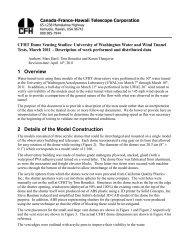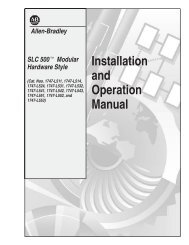Documentation [PDF] - Canada France Hawaii Telescope ...
Documentation [PDF] - Canada France Hawaii Telescope ...
Documentation [PDF] - Canada France Hawaii Telescope ...
Create successful ePaper yourself
Turn your PDF publications into a flip-book with our unique Google optimized e-Paper software.
during photometrically stable conditions to completely cover the Wide patches.<br />
Each Wide tile is covered by at least one L99 exposure which covers 25% of the MegaCam field of view<br />
on each Wide tile. Given that the stacks are photometrically flat within 1% across the field of view due to<br />
the use of the Elixir B5/SNLS recipe, this guarantees that in turn all four quadrants are photometrically<br />
uniform.<br />
Additionally, each L99 observation is preceded and followed by an observation of a CFHTLS Deep field<br />
containing the SNLS tertiary standards.<br />
The photometric measurement method used to calibrate the Deep exposures taken before and after L99<br />
observations follows the same procedure used for CFHTLS Deep stacks described above. The stable<br />
photometric conditions allows this zero-point to be used for the corresponding L99 exposures. In the last<br />
step, L99 images are used to compute rescaling factors which can be applied to the CFHTLS Wide stacks<br />
thanks to the large overlaps, 25% of a MegaCam field-of-view by design of the L99 observing program.<br />
3.7.2 Choice of magnitude measurement method for calibration<br />
In general, in any photometric calibration process, the method used to measure fluxes of the calibrating<br />
sources should be identical to the method used to measure the flux of the science objects. It is challenging<br />
to follow this procedure precisely as described in Regnault et al. for several reasons, none the least is that<br />
CFHTLS is a public survey which addresses many different science objectives, ranging from foreground<br />
stars to unresolved galaxies. In some cases, total magnitudes are important; in others, galaxy colors must<br />
be accurately measured. Ideally, the calibration process should introduce the smallest possible bias which<br />
should be documented and allow users to correct for this bias based on the kind of flux measurement they<br />
wish to perform.<br />
A second important consideration comes from the intermediate step used to calibrate the CFHTLS Wide<br />
survey. The intermediate L99 photometric images have significantly different characteristics compared<br />
to the Wide stacks, as can be seen in Figure 8 which shows the distribution of seeing in L99 calibration<br />
images and in actual CFHTLS Wide images; the distribution of image seeing is quite different between<br />
the two kinds of images, with very large maximum values reported in the L99 stacks (the L99 were observed<br />
under poorer seeing conditions which would have provided out of specifications data for the Wide<br />
data set). Moreover, the exposure times are much shorter in the calibration images resulting in larger<br />
PSF variations across the field of view due to a less effective smoothing over time of the atmospheric turbulence<br />
over the one square degree MegaCam field of view. The method chosen to measure magnitudes<br />
scheme should be insensitive to these kinds of variations in exposure time and image quality.<br />
Since the calibration is carried out using stars, aperture magnitudes are a natural photometric measurement<br />
scheme (and is also fully consistent with the aperture magnitudes scheme used for the SNLS photometric<br />
calibration). This is because, in principle, the correction to total flux is the same for all calibrating<br />
sources (unlike resolved galaxies which may have vastly differing light profiles).<br />
In this work, as in Regnault et al. we choose an aperture magnitude where the aperture diameter scales<br />
with the image seeing:<br />
MAG_SNLS = MAG_APER(7.5 × FWHM) (1)<br />
The factor of 7.5 used by Regnault et al. implies an aperture correction, and in our case we also choose an<br />
aperture 20 times larger than the seeing to model and apply such correction to derive the total magnitude<br />
of stellar like sources, what we call MAG_IQ20. We call seeing the image quality (IQ) based on mea-<br />
13


![Documentation [PDF] - Canada France Hawaii Telescope ...](https://img.yumpu.com/26965302/25/500x640/documentation-pdf-canada-france-hawaii-telescope-.jpg)









